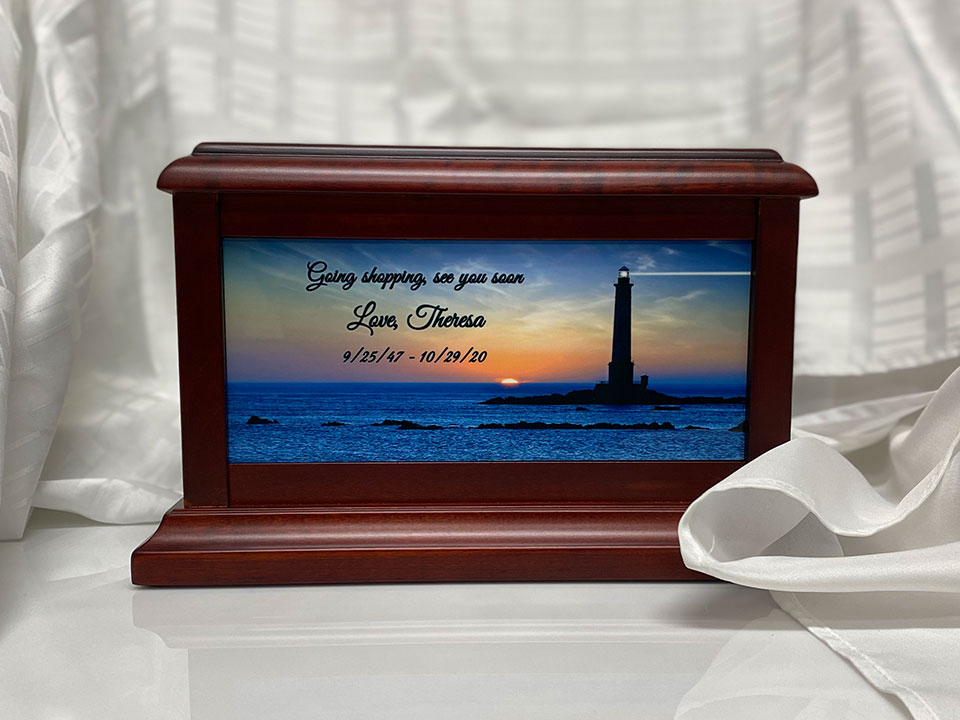Cremation Urn Sizes
Urns come in almost any size and shape you can imagine, from a small piece of cremation jewelry to a large urn meant to hold the remains of several people. When you start browsing for urns, size might not be the first thing on your mind. Before you make a choice, however, you should consider what you will need and how you will fit the urn in its final placement. With this guide, you’ll understand the most common sizes of urns, as well as how you can choose the right one for your loved one.
What Are the Most Common Urn Sizes?
As you look for urns, you’ll notice that they often come in different sizes, with the capacity listed on each item. These sizes have some conventional ranges for capacity, although there may be exceptions. Common sizes include:
- Individual or Standard Adult Urns
- Extra-Large Urns
- Companion Urns
- Keepsake Urns
- Infant or Child Urns
When you evaluate capacity to hold cremains, you can see that urn volume is listed in cubic inches. The volume of ashes you will have depends on various factors, such as age, weight, height, and more. Here are the most common sizes.
Individual/Standard Adult Urns


A standard adult urn ranges from 150 to 200 cubic inches. You may find the most variety in this type, since an individual urn is meant to hold most or all the remains of the average adult. These urns work well for a variety of applications, including placement in an urn vault, columbarium, or display at home.
Extra-Large Urns


An extra-large urn holds 250 to 500 cubic inches, in most cases. These urns help families to contain remains that exceed the most common sizes. For example, the remains of someone who was unusually tall may require an extra-large urn. These urns can also function as companion urns or family urns, particularly if you need a temporary option while you plan for a long-term placement in the future.
Companion Urns


Companion urns are designed to hold the remains of multiple adults, with a capacity ranging from 400 to 600 cubic inches. The main difference between a companion urn and an extra-large urn is that the companion urn is designed for two, while an extra-large urn could hold the remains of multiple people. Companion urns usually feature the information of both on the exterior, and they may come in options to keep the remains separate.
Keepsake Urns


A keepsake urn holds a small portion of a person’s ashes, usually ranging from a pinch of ashes to 50 cubic inches. These urns are perfect for sharing, as part of a scattering ceremony or memorial. Some will hold only a small amount of ashes, so that you can buy several as part of your memorial planning. Others are simply smaller versions of standard urns, meant for display in your home or a permanent placement. In some cases, they can also work to hold the remains of an infant or young child.
Infant/Child Urns


The capacity of infant and child urns ranges from 5 to 150 cubic inches. An infant urn commonly holds 5 to 15 cubic inches, while a child urn may hold 25 to 150 cubic inches. These urns tend to be smaller in dimension as well as capacity. Some urns meant to hold the remains of infants or children may also work as keepsakes.
Urn Size vs. Capacity
When you choose from a selection of urns, you should remember that urn capacity and size don’t always match. A large urn with an elaborate design, for example, may fit cremated remains only in the base. Conversely, a smaller urn that leaves most of the space for the remains may fit more than you think. If you have to fit the urn within certain dimensions, be sure that the urn size and capacity will meet your needs.


5 Steps to Choose the Right Size Urn
1. How Much Volume of Cremated Remains Will You Have?
Buying an urn with sufficient capacity is important, particularly if you plan to keep the remains all in one place. If you’re shopping before you receive the remains from the funeral home or crematorium, you’ll need to estimate the volume you will need in advance. You can get a rough estimate by converting the weight of the person in pounds to cubic inches, although this method is outdated and often wrong. For a more accurate estimate, try our urn size calculator. This tool uses height, weight, age, and other factors to give you a volume measurement in cubic inches and cups.
If you already have the remains in hand, estimating may be easier. For remains in a simple box, you can multiply the height, length, and width in inches to get the approximate volume in cubic inches. If the remains are in a container with an unusual shape, you might prefer to use the calculator.
2. Where Will You Place the Urn?
You may need to confirm that the dimensions will work for the urn’s placement, in addition to its volume. If you are shopping for a burial urn, typically for placement in a cemetery plot, it will need to fit inside an urn vault. For placement in a cemetery’s columbarium, you should ask about the size of the niche. Columbaria may have niches in different sizes in the same structure, so be sure that you have the right information.
Placement at home gives you much more freedom in sizing, depending on your preferences. If you plan to build a display or other décor to go with the urn, set a box, vase, or other item in the right place to aid your planning. This step can help you avoid buying an urn that is too large or small for the design.
3. Will You Share the Ashes or Keep Them Together?
Although many families decide to keep the ashes in a single urn, others prefer to spread the ashes among multiple people. The right decision depends on the person and the needs of the family. It is not uncommon to divide up the remains, setting aside portions for scattering, keepsakes, burial, or display at home.
If you choose to share the remains, keepsake urns and cremation jewelry urns are the most popular options. Cremation jewelry usually holds about a pinch of ashes, so you may need more keepsakes or a standard urn to hold the remainder.
4. Will You Add More Ashes in the Future?
Just like families often buy burial plots next to each other, your loved ones may want to have a final resting place near those they love. Planning ahead can be tricky, especially if a loved one passes unexpectedly and you don’t have time to prepare. A long-term placement of the remains of multiple people usually involves companion urns or family urns. If you’re not sure what you want to do, consider buying an extra-large urn to give you the space and time to decide. As long as the urn isn’t buried permanently, you can transfer the remains from one urn to another.
5. What Is Your Budget?
Before you make the final selections, consider your budget. Typically, larger urns cost more than smaller ones, although there are exceptions for expensive materials or uncommon designs. Here are general price ranges for the most common sizes:
- Standard Urns: $150 to $500
- Extra-Large Urns: $250 to $700
- Companion Urns: $200 to $700
- Keepsake Urns: $10 to $150
- Cremation Jewelry: $50 to $600 or more
- Infant/Child Urns: $50 to $300
How to Start Shopping for a Cremation Urn
Now that you have the general information about common urn sizes and the best way to find the limits on the size you need, you may be ready to start shopping for an urn. Keep these factors in mind as you browse:
- Urn type
- Urn size and capacity
- Plans to share or divide the remains into keepsakes or smaller urns
- Plans to combine the remains with others, in a companion or family urn
- Budget for the number of urns you want to buy
At In The Light Urns, we offer a wide selection of urns with varying size and capacity to meet your needs. If you need extra help in determining the right size to buy, or if you have other questions about choosing an urn, our customer service team is happy to assist. Contact us to learn more.
Key Takeaway:
Cremation urns come in different sizes to accommodate for different needs. A standard adult urn usually holds around 200 cubic inches. Extra-large urns for larger adults range between 250-500 cubic inches in volume, while companion urns, intended to store the ashes of two or more people, hold between 400-600 cubic inches. Keepsake urns, infant urns, and child urns are all smaller than standard adult urns. Keepsake urns are meant to hold only a portion of a loved one’s ashes and can range between 5-50 cubic inches in volume. An infant urn may hold between 5-15 cubic inches, while a child urn can hold 25-150 cubic inches.
MEET THE FOUNDER
Susan Fraser
Susan Fraser, founder of In the Light Urns, Inc., has spearheaded innovation in the memorial industry since 2001. After a personal tragedy, she began creating custom cremation urns for ashes that reflect a lost loved one's individuality. Susan's commitment to comfort makes her an authority on cremation and memorials, guiding and consoling families through understanding and compassion. With expertise and dedication, Susan's cremation guides give families invaluable resources for informed decisions.


Cremation Education
Cremation education informs diverse practices and ethics, empowering informed end-of-life choices.







